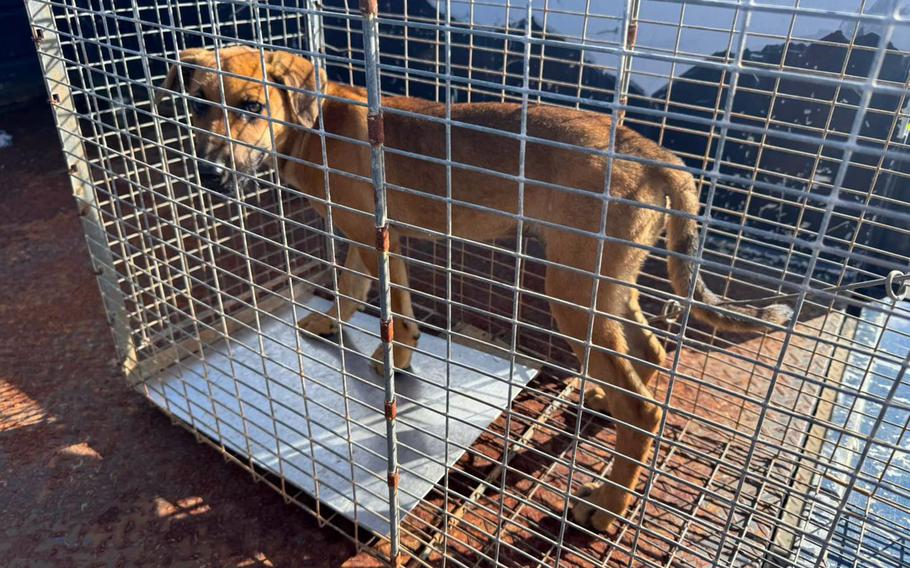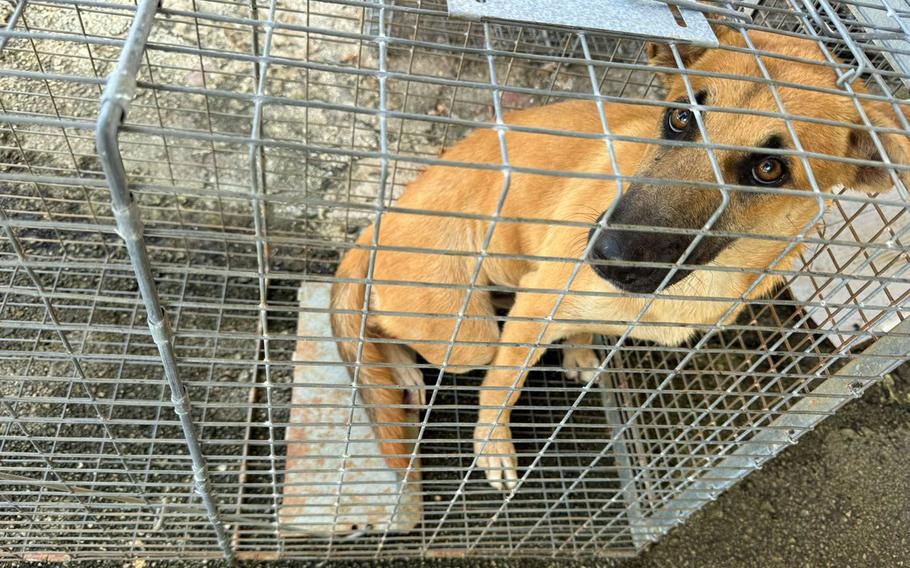
This image from the 36th Wing Commander Facebook page shows a boonie dog captured in November 2024 on Andersen Air Force Base, Guam. (U.S. Air Force/Facebook)
Guam’s stray dog population recently found the social media spotlight when one of them made itself at home outside the headquarters of Andersen Air Force Base.
Video footage of a “boonie dog” was posted Nov. 25 by Brig. Gen. Thomas Palenske on his Facebook page, 36th Wing Commander. The inquisitive mutt was captured sniffing around the lawn and beneath an automobile.
Palenske’s post cited reports of the local animal shelter having run out of space.
“This guy has taken up residence at my Headquarters Building in a show of defiance,” he wrote.
Approximately 30,000 boonie dogs roam the island’s 212 square miles, an area about the size of Chicago, Alison Hadley, executive director of Guam Animals in Need, the shelter operator, told Stars and Stripes by email Monday.
The organization responded to Palenske’s post to say it was able to accept boonie dogs again.
“We are back in business, thanks to our friends at GAIN reaching out to us!!” Palenske wrote.
The general’s plea focused fleeting attention on Guam’s overpopulation of strays, a problem that traces to World War II. A 2014 survey by Humane Society International found about 60,000 dogs on Guam, of which 24,500 were stray, Hadley said.
“The lineage of boonie dogs largely comes from the working dogs of World War II, many of which were left on Guam after the war ended,” she said. “These working dogs, mixed with the dogs that came with the Spaniards, made for several sort of ‘strains’ of dogs on the island; many of which lived in the jungles of the island (or boonies), hence the name boonie dog.”

This image from the 36th Wing Commander Facebook page shows a boonie dog captured in October 2024 at Northwest Field on Andersen Air Force Base, Guam. (U.S. Air Force/Facebook)
The large jungle near the base provides hiding space and potential meals for the boonie dogs, Hadley said.
“Andersen frequently deals with boonie dog issues which can cause public safety concerns as well as safety issues on the flight tarmac areas and other working zones,” she said. “Over the last few years, Andersen has become very active in boonie dog trapping efforts to prevent and control any health and safety issues potentially caused by the dogs.”
The base Civil Engineer Squadron Etymology Flight has caught 87 dogs so far this year, base spokesman Capt. Casey Bell said by email Thursday.
Since Super Typhoon Mawar, boonie dog sightings at Andersen have dropped 75%, Bell said.
When strays are turned over to GAIN, there is a three-day holding period while their health and temperament are evaluated for the dog’s potential adoption.
“If the animal is, unfortunately, deemed not adoptable due to health concerns or temperament issues, the animal is humanely put to sleep,” Hadley said. “While this is a tough reality, it is a reality nonetheless due to the sheer number of animals on this island and a lack of additional resources.”
Hadley said GAIN favors another solution to the canine overpopulation on Guam.
“The only way to dig ourselves out of this overpopulation problem is to provide low cost spay and neuter efforts to the island,” she said. “One cannot cull or kill their way out of this issue; it must be done by truly managing the population’s ability to procreate.”